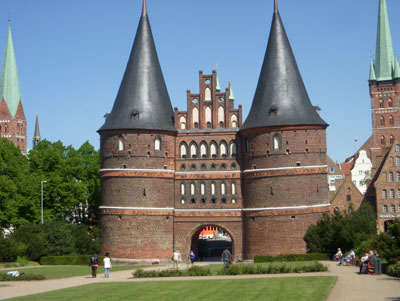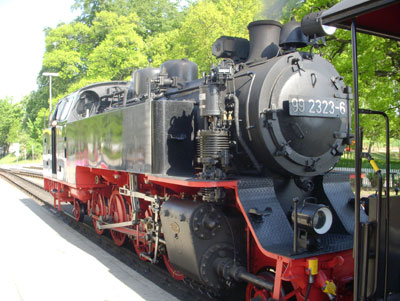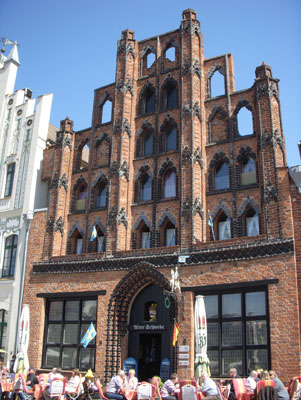The Red Brick Road
This item appears on page 59 of the October 2009 issue.
by Jay Brunhouse
On May 9, 2009, I started to follow the Red Brick Road in Rostock, on Germany’s Baltic seacoast, which I reached by an easy 2½-hour Regional Express train ride from the deep subterranean north-south tracks of Berlin’s new Hauptbahnhof.
The Red Brick Road took me through cities that hark back to the Middle Ages, with towering Brick Gothic structures confirming the prosperity of the cities. I visited three UNESCO World Heritage Sites and admired majestic Brick Gothic legacies.
Red brick is a difficult construction material, but, without alternative building materials, artisans of the Hanseatic League quickly mastered forming and burning bricks in kilns. The kilns required wood. Hansa merchants traded with Scandinavian merchants for this commodity.
They built unadorned, austere, towering Brick Gothic architectural monuments. Builders burned not only oblong blocks but decorative shapes and perfected glazing them. Gifted designers added imaginative openings and beautiful rose windows to their Brick Gothic churches during the golden age of the Hanseatic League.
The German Hansa
The German Hansa, which began as an association of rich north German merchants with the sole idea of making money, developed in the mid-14th century into a community of cities whose might and power expanded until the trading league was stronger than the hodgepodge of duchies and principalities that existed in the Middle Ages.
The most important and lasting members of the league were Lübeck, Bremen and Hamburg. The league ruled its member cities with a hand of iron and developed the whole wonderful system of civic laws that gave peace and freedom to the countries.
Rostock became so powerful and rich that there were 22 city gates for 15,000 inhabitants. Rostockers traded herring, corn and beer — especially beer; there were 250 breweries. Beer was brewed in every third house. Rostockers consumed 10 to 15 liters per person per day. Water was so foul that they used beer for washing clothes and hair as well as for soup.
In 1419, Rostock founded the first Hanseatic university, and by 1476 the city was Germany’s second-most active center of printing (after Lübeck). Now the university is Germany’s smallest, with 14,000 students.
During the Second World War, Rostock was heavily bombed, especially the Neptun shipyards and the Heinkel aircraft factory that produced the world’s first jet airplane. In April 1942 the city was 50% destroyed. The East German government rebuilt the city along Socialist lines, with precast concrete slabs covered with façades looking like red brick. Few traces of the once-prosperous Hansa city survive.
Puffing aboard Molli
From Rostock to Bad Doberan, it is only a 15-minute hop by GermanRail Regional or S-Bahn rapid-transit train. The 1386 Bad Doberan Minster is regarded as the crowning glory of Brick Gothic style. In Bad Doberan, I boarded the 120-year-old narrow-gauge steam train named “Molli” (www.molli-bahn.de) and casually puffed on narrow-gauge rails through the resort centers to Kühlungsborn on the Baltic Sea.
Wismar, my next city on the Red Brick Road, only 25 minutes by train from Rostock, is a very special city brimming with carefully restored merchant houses, cafés and restaurants of Brick Gothic architecture. The Wismarers traded fish and spices, wax, malt and salt and became prosperous. Wismar’s gemstone city square is surprising and splendid. It is one of the largest in Germany.
Wismar is a UNESCO World Heritage Site, so named, together with Stralsund, for its contributions to the development of Brick Gothic in the Baltic region. Wismar’s historic St. Georgen Church is the city’s largest. St. Nikolai Church was once the place of worship of sailors and fishermen and is one of the tallest churches in Germany. The steeple of St. Marien Church, the former town church, is Wismar’s logo.
Queen of the Hansa
Getting to Lübeck takes only one hour 10 minutes by Regional Express train from Wismar, including the change of train in Bad Kleinen.
Lübeck took its place at the head of the Hansa by 1375. Named a UNESCO World Heritage Site in 1987, Lübeck’s oval Old Town contains some of Germany’s most outstanding Brick Gothic buildings. The seven church spires have dominated the city skyline since the Middle Ages.
Lübeck’s 1447 Holstentor (Holsten Gate) is famous throughout the world. The monumental work of art was completed even before Lübeck’s fortification wall. The merchant’s majestic 1250-1350 Brick Gothic Church of St. Mary, which is Germany’s third largest, dwarfs Lübeck’s ecclesiastical Cathedral.
Hamburg is a 40-minute ICE train journey from Lübeck. Despite the distance, stevedores unloaded heavy grain and lumber cargoes at Lübeck, carted them by land to Hamburg and then reloaded them for shipment to the New World.
Hamburg’s old title of free and Hanseatic town, St. Catherine’s Brick Gothic church built in the 14th and 15th centuries and Hamburg’s status of city state reflect its longtime importance. Its autos’ license plates still begin with HH, for Hansa city Hamburg.
I thank the German National Tourist Office (www.cometogermany.com) in New York for inviting me to the highly successful German Travel Mart in Rostock as well as on the following trip along the Red Brick Road.
In Berlin I stayed at the Maritim Hotel (phone +49 [0] 30 2065 0, www.maritim.de/de/inhalt), across from the Stauffenberg Memorial, with rates from €115 (near $161). In Rostock-Warnemünde I stayed at the Yachthafen Residenz Hohe Duene (phone +49 [0] 381/50 40-0, www.hohe-duene.de), with rates from €139. In Hamburg I enjoyed the InterContinental Hotel (phone +49 [0] 40 41 42 0, www.hamburg.intercontinental.com), with rates from €127.
Lufthansa’s nonstop transatlantic flights to Germany from its North American terminuses stand above the competition.
Jay Brunhouse is pleased to answer readers’ questions e-mailed to railfox@aol.com. Please use “ITN” in the subject line.



